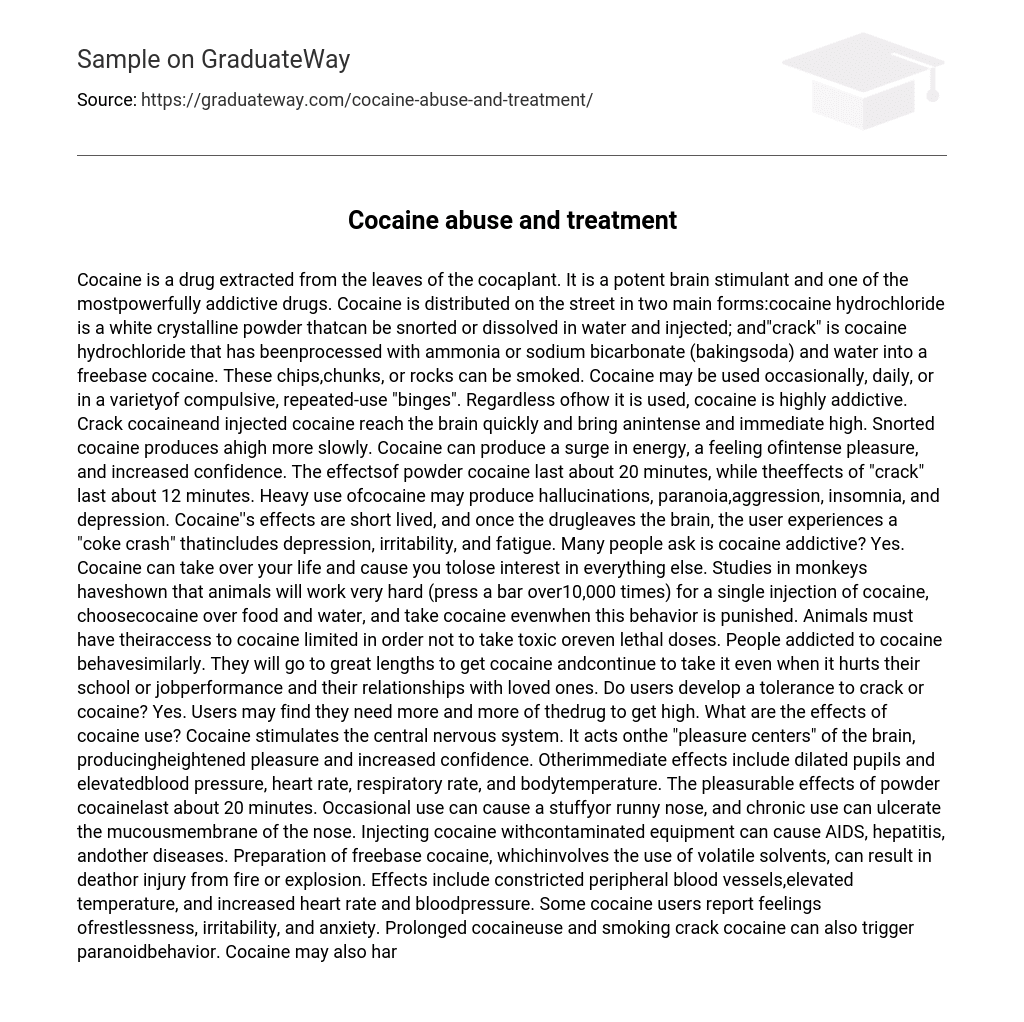Cocaine is a drug extracted from the leaves of the cocaplant. It is a potent brain stimulant and one of the mostpowerfully addictive drugs. Cocaine is distributed on the street in two main forms:cocaine hydrochloride is a white crystalline powder thatcan be snorted or dissolved in water and injected; and”crack” is cocaine hydrochloride that has beenprocessed with ammonia or sodium bicarbonate (bakingsoda) and water into a freebase cocaine.
These chips,chunks, or rocks can be smoked. Cocaine may be used occasionally, daily, or in a varietyof compulsive, repeated-use “binges”. Regardless ofhow it is used, cocaine is highly addictive. Crack cocaineand injected cocaine reach the brain quickly and bring anintense and immediate high. Snorted cocaine produces ahigh more slowly. Cocaine can produce a surge in energy, a feeling ofintense pleasure, and increased confidence.
The effectsof powder cocaine last about 20 minutes, while theeffects of “crack” last about 12 minutes. Heavy use ofcocaine may produce hallucinations, paranoia,aggression, insomnia, and depression. Cocaine”s effects are short lived, and once the drugleaves the brain, the user experiences a “coke crash” thatincludes depression, irritability, and fatigue.
Many people ask is cocaine addictive? Yes. Cocaine can take over your life and cause you tolose interest in everything else. Studies in monkeys haveshown that animals will work very hard (press a bar over10,000 times) for a single injection of cocaine, choosecocaine over food and water, and take cocaine evenwhen this behavior is punished. Animals must have theiraccess to cocaine limited in order not to take toxic oreven lethal doses.
People addicted to cocaine behavesimilarly. They will go to great lengths to get cocaine andcontinue to take it even when it hurts their school or jobperformance and their relationships with loved ones. Do users develop a tolerance to crack or cocaine? Yes. Users may find they need more and more of thedrug to get high. What are the effects of cocaine use? Cocaine stimulates the central nervous system. It acts onthe “pleasure centers” of the brain, producingheightened pleasure and increased confidence. Otherimmediate effects include dilated pupils and elevatedblood pressure, heart rate, respiratory rate, and bodytemperature.
The pleasurable effects of powder cocainelast about 20 minutes. Occasional use can cause a stuffyor runny nose, and chronic use can ulcerate the mucousmembrane of the nose. Injecting cocaine withcontaminated equipment can cause AIDS, hepatitis, andother diseases. Preparation of freebase cocaine, whichinvolves the use of volatile solvents, can result in deathor injury from fire or explosion. Effects include constricted peripheral blood vessels,elevated temperature, and increased heart rate and bloodpressure. Some cocaine users report feelings ofrestlessness, irritability, and anxiety.
Prolonged cocaineuse and smoking crack cocaine can also trigger paranoidbehavior. Cocaine may also harm the health anddevelopment of infants born to women who use cocaineduring pregnancy. When addicted individuals stopusing cocaine, they often suffer from depression andanxiety, and the inability to experience pleasure fromnormally pleasurable activities. This makes it extremelydifficult or the recovering addict to stay clean.
Cocaine in its freebase form is extremely addictive, andits effects are felt within 10 seconds. The physical effectsinclude dilated pupils, increased pulse rate, elevatedblood pressure, insomnia, loss of appetite, tactilehallucinations, paranoia, and seizure. The use of cocainecan cause death by cardiac arrest or respiratory failure. Appearance of cocaine.
Cocaine sold on the street is in the form of a whitepowdery substance. it resembles snowflakes, crystal orlactose. This accounts for two of its nicknames: “crystal”and “snow”. It is “cut” for street sale, much like heroin.(This means the drug is diluted with some othersubstance.) In street samples cocaine purity ranges anywhere from 15% – 50% with an average purity of 25%cocaine.
Cocaine is cut with mannitol, lactose, insitold,etcUnder the Influence Symtoms Under the influence of cocaine means that there isphysical evident cocaine present in the body such asdilated pupils, hyperactive nervous system, musclerelaxation, and cocaine found in blood or urine. Sincecocaine”s activity level in the body is 3-6 hours followinguse the term “under the influence” is restricted to userswho show physical evidence of cocaine during itsactivity period of 3-6 hours.
Persons using cocaine can show evidence of thefollowing: Rapidity of speech (low dose) Aggitated or hyperstimulated appearance (lowdose) Slowing or slurred speech (high dose) Sedated or sleepy (high dose) High pulse and respiration rate Pupil size will be dilated Needle marks Presence of cocaine in nasal passage Hallucinations or delusions How many people use cocaine? The number of regular cocaine users has declined by75% since 1986. In 1995, according to the NationalHousehold Survey on Drug Abuse, an estimated 1.45million Americans were current cocaine users; that is,they had used cocaine at least once in the past month.
Of that number, an estimated one-half million werecurrent crack users. As in the past, the rate of currentcocaine use was highest among young adults. In 1995,approximately 54% of current cocaine users were agedbetween 18 and 34.
Reference
- Pollack MH, Brotman AW, Rosenbaum JF. “Cocaine abuse and treatment.” ComprehensivePsychiatry 1989 Jan- Feb;30(1):31-44.
- Vandette JM, Cornish LA. “Medicalcomplications of illicit cocaine use.” Clin Pharm1989 Jun;8:401-11.





